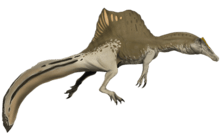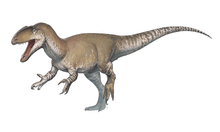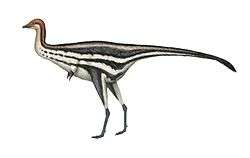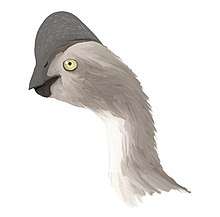Alxasaurus
Alxasaurus (/ˌɑːlʃəˈsɔːrəs/; meaning "Alxa lizard") is a genus of therizinosauroid theropod dinosaurs from the Early Cretaceous Albian age Bayin-Gobi Formation of Inner Mongolia. They are some of the earliest known members of the Therizinosauroidea, but they already possessed the body shape—including the long neck, short tail, and relatively large claws—of later therizinosauroids. Like other members of this group, it was a bipedal herbivore with a large gut to process plant material. Several specimens are known and they vary in size.
| Alxasaurus | |
|---|---|
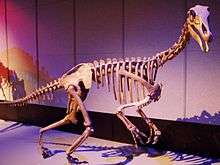 | |
| Restored skeleton mount at the Royal Tyrrell Museum of Palaeontology | |
| Scientific classification | |
| Kingdom: | Animalia |
| Phylum: | Chordata |
| Clade: | Dinosauria |
| Clade: | Saurischia |
| Clade: | Theropoda |
| Clade: | †Therizinosauria |
| Superfamily: | †Therizinosauroidea |
| Genus: | †Alxasaurus Russell & Dong, 1993 |
| Type species | |
| †Alxasaurus elesitaiensis Russell & Dong, 1993 | |
History of discovery
The fossil remains were first discovered in 1988 and described by the Canadian paleontologist Dale Russell and his Chinese colleague Dong Zhiming in 1993. However, although the paper is technically included in the last issue of the 1993 volume of the Canadian Journal of Earth Sciences, this issue was actually released in the early weeks of 1994.[1]

Alxasaurus is named after the Alxa Desert of Inner Mongolia, also known as the "Alashan" desert, and the name also includes the Greek word sauros ("lizard"). Alxa (or Alashan) is also the name of the league, or administrative division, of the Inner Mongolia (Nei Mongol Zizhiqu) region of the People's Republic of China. The single known species, elesitaiensis, is named after Elesitai, a village found in this region, near which the fossil remains of Alxasaurus were located.[1]
Five Alxasaurus specimens were recovered from the Bayin-Gobi Formation of Inner Mongolia, which dates to the Albian stage of the Early Cretaceous Period, or about 113 million to 100 million years ago. The holotype specimen, IVPP 88402 (large individual), which is considered to exemplify the genus and species, is the largest and most complete of the five, consisting of the right dentary (lower jaw) with some teeth, 5 cervical vertebrae, 28 caudal vertebrae, 5 sacral vertebrae, 9 ribs, 15 chevrons, an isolated scapula, both coracoids, both humeri, isolated radius, both ulnae, a virtually complete manus, both ilia, both ischia and both femora. The other four specimens are the paratypes IVPP 88301, IVPP 88402 (small individual), IVPP 88501 (immature individual) and IVPP 88510. Together the specimens represent most of the species hypodigm aside from the skull.[1]
Classification
While exhibiting many typical therizinosaur features in overall body shape and in the teeth, the skeleton of Alxasaurus also shows several features present in more typical theropods, and the discovery of this animal provided significant evidence that therizinosaurs were aberrant theropods. Specifically, the semilunate carpal bone of the wrist is found only in maniraptoran theropods, which also include oviraptorosaurs, dromaeosaurs, troodontids, and birds.[1] Even more basal therizinosaurs such as the feathered Beipiaosaurus and primitive Falcarius have since been discovered with more theropod features and have helped to solidify this arrangement.[2][3] Alxasaurus is now thought to occupy a position between the early Beipiaosaurus and later therizinosaurids such as Erlikosaurus, Segnosaurus, or Therizinosaurus.[4][5]
Although Rusell and Dong coined the Alxasauridae to contain Alxasaurus,[1] the subfamily has not been widely corroborated in most analyzes. The paleontologist Lindsay E. Zanno noted that this group was of dubious use and tentatively considered it to remain valid.[4]
The following cladogram is based on the phylogenetic analysis conducted by Hartman et al. 2019:[5]
| Therizinosauria |
| |||||||||||||||||||||||||||||||||||||||||||||||||||
See also
References
- Russell, D. A.; Dong, Z. (1993). "The affinities of a new theropod from the Alxa Desert, Inner Mongolia, People's Republic of China". Canadian Journal of Earth Sciences. 30 (10): 2107−2127. Bibcode:1993CaJES..30.2107R. doi:10.1139/e93-183.
- Xu, X.; Tang, Z.-L.; Wang, X. L. (1999). "A therizinosauroid dinosaur with integumentary structures from China". Nature. 339 (6734): 350–354. Bibcode:1999Natur.399..350X. doi:10.1038/20670. ISSN 1476-4687.
- Kirkland, J. I.; Zanno, L. E.; Sampson, S. D.; Clark, J. M.; DeBlieux, D. D. (2005). "A primitive therizinosauroid dinosaur from the Early Cretaceous of Utah". Nature. 435 (7038): 84–87. Bibcode:2005Natur.435...84K. doi:10.1038/nature03468. PMID 15875020.
- Zanno, L. E. (2010). "A taxonomic and phylogenetic re-evaluation of Therizinosauria (Dinosauria: Maniraptora)". Journal of Systematic Palaeontology. 8 (4): 503−543. doi:10.1080/14772019.2010.488045.
- Hartman, S.; Mortimer, M.; Wahl, W. R.; Lomax, D. R.; Lippincott, J.; Lovelace, D. M. (2019). "A new paravian dinosaur from the Late Jurassic of North America supports a late acquisition of avian flight". PeerJ. 7: e7247. doi:10.7717/peerj.7247. PMC 6626525. PMID 31333906.



